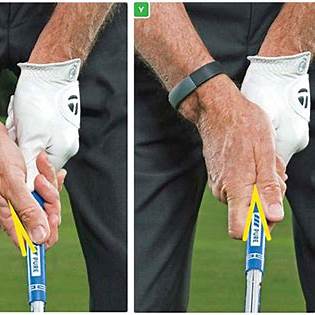Introduction
Learning the basics of a good golf swing can dramatically improve your performance on the course.
As a beginner, it's crucial to master foundational techniques early to avoid developing bad habits. Here are five simple yet highly effective golf swing tips every new golfer should practice.
1. Grip Correctly
Your grip directly influences the control and power of your swing. To grip correctly, position your hands comfortably around the club with your top hand slightly rotated inward.
Make sure your hands are relaxed yet firm enough to maintain control.
The grip is your connection to the club, influencing everything from the accuracy of your shot to the overall distance you achieve.
Begin by placing the club handle diagonally across the base of your fingers on your leading hand (left hand for right-handed golfers).
Next, close your hand gently around the club so that your thumb and index finger create a 'V' shape pointing towards your right shoulder.
Your trailing hand (right hand for right-handed golfers) should cover the thumb of your leading hand. Ensure your palms are facing each other to maintain maximum control.
Many beginners grip the club too tightly, causing muscle tension and reducing swing flexibility and speed.
Remember, your grip pressure should be firm but relaxed—imagine holding a tube of toothpaste without squeezing out any contents.
Frequent grip checks during your practice can reinforce proper technique. Additionally, adjusting your grip slightly can help correct issues such as slicing or hooking the ball.
Practicing your grip regularly at home, even without swinging, helps build muscle memory. Utilize training aids like grip trainers or alignment sticks to help ensure proper positioning during practice.
Always consult with a coach or use visual references to confirm your grip technique aligns with best practices. Investing time in mastering your grip will significantly enhance your consistency and performance.
Common Mistakes to Avoid:
- Gripping too tightly
- Incorrect hand alignment
2. Maintain a Balanced Stance
A balanced stance sets the foundation for a consistent and powerful swing. Position your feet shoulder-width apart with your knees slightly flexed. Ensure your weight is evenly distributed on both feet.
A proper stance starts with aligning your feet parallel to your target line. Imagine standing on railway tracks—your feet should align with one track, and your ball position should align with the other.
Maintain slight flexion in your knees to help absorb impact and allow smooth rotation through your swing. Distribute your weight evenly, avoiding leaning too far forward or backward, which can cause instability and affect swing accuracy.
Keeping your weight balanced helps you stay centered and facilitates a smooth swing plane.
Balance drills such as swinging with your feet close together or practicing on uneven surfaces can improve your overall stability.
Another useful exercise involves closing your eyes while making gentle swings, enhancing your body's ability to maintain balance without visual cues.
Strengthening your core muscles through targeted fitness exercises also significantly improves your stance stability and swing consistency.
A balanced stance not only increases shot accuracy but also reduces the risk of injury by promoting correct posture throughout the swing.
Simple Balance Drill:
- Practice swinging while keeping your feet stable to develop balance and coordination.
3. Ensure Proper Alignment
Correct alignment helps your shots stay accurate. Imagine a straight line from your target through your ball and align your body parallel to this imaginary line. Use alignment rods during practice to improve this essential aspect.
Alignment is vital for hitting the ball accurately towards your intended target. Start by visualizing a straight line running from your target to your ball.
Position your feet, hips, and shoulders parallel to this line. Using alignment rods or clubs placed on the ground can dramatically improve your setup accuracy.
Many golfers mistakenly align themselves directly towards the target instead of parallel, causing shots to veer off course.
Regularly checking your alignment before each swing can quickly become a beneficial habit.
To improve alignment consistency, practice by picking intermediate targets, such as a blade of grass or leaf, between your ball and target. Setting up parallel to these small targets ensures your larger target alignment is accurate. Video analysis during practice sessions can also highlight any alignment inconsistencies, enabling quicker corrections.
Consistent practice using alignment tools and visual cues enhances muscle memory and promotes accurate shots on the course.
Alignment Checkpoints:
- Feet
- Hips
- Shoulders
4. Develop a Controlled Swing Tempo
Swinging the club with consistent tempo helps enhance your accuracy and distance control. Focus on a smooth, rhythmic backswing and downswing rather than rushing your motion.
Tempo refers to the rhythm and timing of your swing. A common mistake among beginners is rushing the swing, causing poor shot accuracy and inconsistent contact.
A controlled, even tempo allows your body and club to move in harmony, maximizing efficiency and precision. An ideal swing tempo should feel natural and rhythmic, like a pendulum motion.
To develop a consistent swing tempo, practice drills like counting to three: one-two for the backswing, and three for the downswing.
Using a metronome or swing tempo trainer during practice can reinforce proper timing. Additionally, filming your swing periodically helps identify and correct any tempo irregularities.
Maintaining a consistent breathing pattern can also aid in tempo control, as steady breathing promotes relaxation and rhythm.
Swing Rhythm Drill:
- Count “one-two” for your backswing and “three” on your downswing to maintain consistent timing.
5. Complete Your Follow-Through
Your swing doesn’t stop once the club hits the ball. A complete follow-through ensures power transfer and accuracy. Your body should face the target, and your club should naturally finish over your shoulder.
Proper follow-through is essential to effectively transferring power to the golf ball and maintaining directional control.
A complete follow-through indicates a fluid, balanced swing and ensures your clubhead travels along the correct path.
After striking the ball, rotate your hips and torso towards the target until your body fully faces forward, and your club finishes naturally high over your shoulder.
Practice drills such as holding your follow-through position after every shot can reinforce correct technique and balance.
Observing your finishing position during practice sessions provides immediate feedback regarding your swing mechanics and balance.
Developing a consistent follow-through habit helps to ensure maximum efficiency, improved accuracy, and reduced likelihood of injury.
Follow-Through Exercise:
- Practice finishing your swing fully, holding your position to reinforce proper mechanics.


